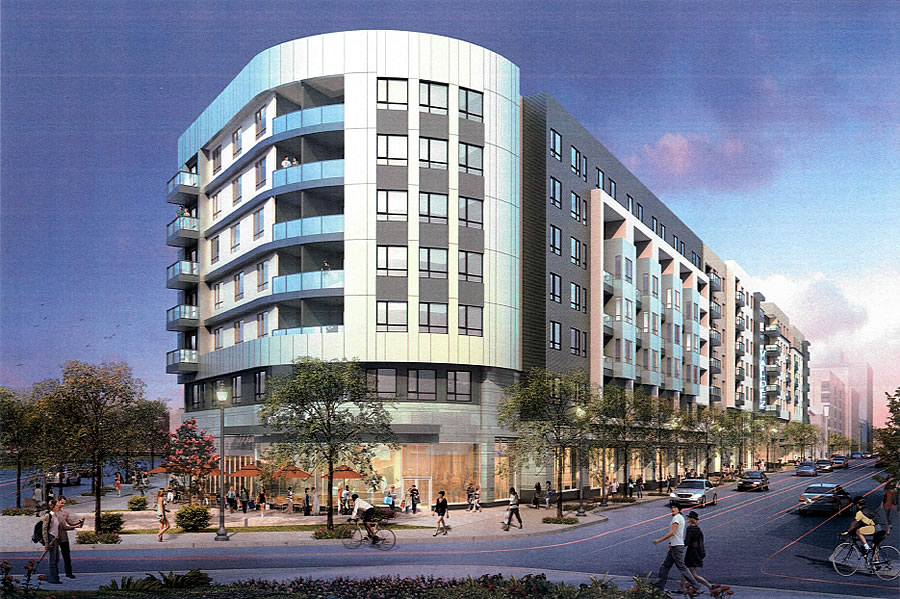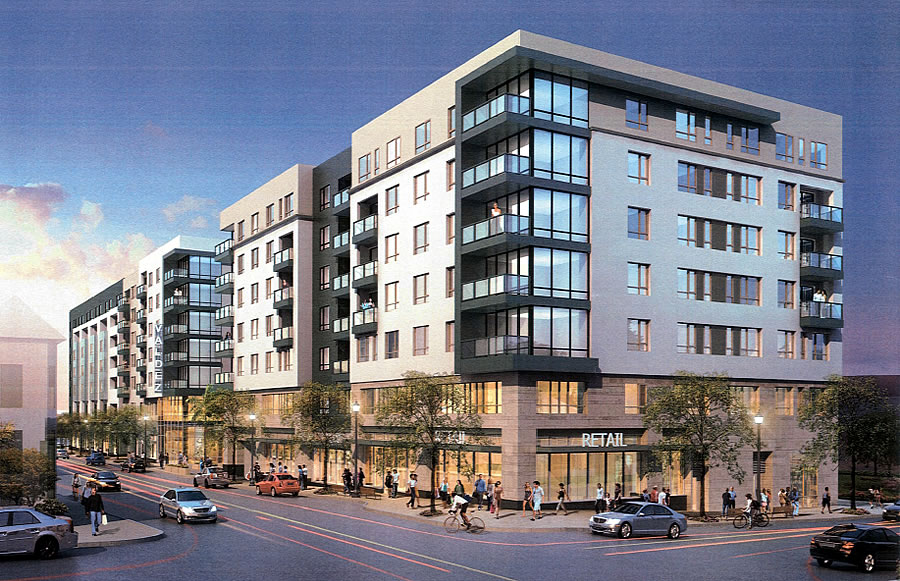While the plans for a seven-story Oakland development with 225 apartments over 23,000 square feet of retail space at 2400 Valdez Street were granted a key neighborhood plan-based exemption from having to complete a project specific environmental review in March, an appeal of the exemption has been filed.
Leading the charge is an unincorporated association of individuals and labor organizations dubbed “Oakland Residents for Responsible Development.” The group claims to have “identified several flaws in the Project analysis as well as new information regarding new or more severe impacts than previously analyzed” in Oakland’s Broadway Valdez District Specific Plan, an approved plan which allows the City to grant projects an exemption from having to complete an individual Environmental Impact Report (EIR).
And while the appeal was likely filed as leverage for labor negotiations, versus out of concern for enforcing the State’s environmental laws, if successful, it could result in significant delays and added expense, not only for the 2400 Valdez project but for others developments within Oakland’s Broadway Valdez District as well.
The Hanover Company had been planning to break ground for the two-year project as early as July.


Laura Horton of Adams Broadwell Joseph and Cardozo is likely repping IBEW in this complete abuse of CEQA. I’m worried… D3 council member Lynette McElhaney is in high campaign mode and courting the unions like they are her actual constituents.
do you have a article link explaining this a little more?
Here you go: Oakland Approves Lake Merritt Mixed-Use Project at 2400 Valdez
Unions use lawyers now for intimidation…er, education? Whatever happened to baseball bats and brick thru windows? Even Philly is more creative.
clearly an offensive political blocking play — low class, IMO. this kind of project is just the thing we need in oakland. it’s a parking lot, right now, surrounded by other parking lots, in an area ripe for density. doubly unfortunate is that an EIR is designed to make a project like this look bad (mostly from a transit/traffic perspective). if we can’t even build this, chances of oakland’s rent stabilizing are slim.
Most of those union electricians don’t even live in Oakland, but in the surrounding suburbs and farther out. They could give a rat’s patootie about housing affordability in Oakland. They just wanna get PAID. Watch this disappear in a cloud of smoke as soon as the developer agrees to hire an electrical sub that is an IBEW signatory.
IBEW left Oakland in 1989 claiming their Oakland building was damaged beyond repair in the Loma-Prieta quake. A church was able to cheaply retrofit the building on MLK and it’s still in use today.
Completely not surprised.
On a related note: an update on it’s perhaps-soon-to-be-ex neighbor across the street.
THAT is the exact kind of garbage that’s making people leave the Bay Area. Fighting to preserve a dump that has been vacant since the 90’s is insane.
It’s a little more complicated than that: IIRC the original reason it (was) closed was that Chevron, which had a station on the corner fronting Broadway, wanted to replace it with a Mc Donalds; but that was heavily opposed by a large number of people, for a large number of reasons (beyond preservation). And during that prolonged period it became “a dump.” So one possible lesson is that property owners shouldn’t shut down one business in hopes of creating another, unless they’re reasonably sure the new plan is viable.
As for this being “the exact kind of garbage that’s making people leave the Bay Area”, I’m pretty sure it’s far down the list, if it’s on it at all.
So people who fight to preserve derelict properties in favor of new housing has nothing to do with the housing crisis that is driving people out of the Bay Area? People stuck in 1960 who think nothing should ever change unless it’s restored to it’s 1960’s “glory” aren’t making things worse?
“Cost of living, housing and traffic were cited as the leading concerns,” and while more housing might alleviate the second concern – assuming, of course, more housing doesn’t encourage even more people to want to move here – it would likely aggravate the third. And I never said “nothing to do with”, I said “far down the list”: if you can produce evidence that double-digit percentages of people want to leave b/c of efforts to preserve Biff’s/JJ’s, or even derelict buildings in general, I’ll gladly retract my comment.
I feel like I’m seeing a ton of articles on SocketSite that start with “Project X was granted an EIR exception, Group Y is suing to stop the project based on EIR exception…”, and I’m starting to wonder why they ask for the EIR exception if it’s just an open door for a lawsuit.
Does an EIR take longer / cost more than the legal headache these NIMBY / Whoever groups inflict on project after project?
As described correctly by SocketSite, it is a CEQA “exemption” not “exception”. The State CEQA Guidelines allow for streamlined environmental review for projects that are “consistent with the development density established by existing zoning, community plan, or general plan policies for which an EIR was certified, except as might be necessary to examine whether there are project-specific significant effects that are peculiar to the project or its site.” Section 15183(c) of the Guidelines specifies that “if an impact is not peculiar to the parcel or to the proposed project, has been addressed as a significant effect in the prior EIR, or can be substantially mitigated by the imposition of uniformly applied development policies or standards…, then an EIR need not be prepared for the project solely on the basis of that impact.”
In the case of the 2400 Valdez Street project, the City of Oakland certified a program-level EIR for the Broadway Valdez District Specific Plan in 2014. Because the project is within the development envelope established by the Specific Plan and the potential environmental impacts were evaluated in the 2014 EIR, further CEQA analysis is not required other than documenting that it qualifies for the exemption. And yes, EIRs can take a long time, are expensive, and are subject to their own legal challenges.
Correct. The purpose of this appeal is not to actually stop the project, but to add a possible long delay and additional EIR analysis. The idea is that the cost of the delay will be greater than the cost of a project labor agreement.
Sorry, I meant exemption. I still see a number of people trying to halt projects by suing over this, which makes me question if using the exemption is worth it in the end.
Challenges of exemptions, which can shave a few years and seven figures from the budget of a project, are relatively uncommon. Challenges of a project or area plan EIR are not uncommon and might be what you have been noticing, in part due to the volume of recent EIR activity.
I live in the Valdez/Broadway/Telegraph/Northgate/Koreatown/Grande/Uptown neighborhood or just Uptown for short. I don’t see anything wrong with construction here as long as it is on parking lots or empty buildings. It would have been fine as is so I hope the Oakland Residents for Responsible Development (ORRD?) drop this case. They should instead be stopping developments that Ellis Act (using noun as verb) current residents.
If they were to change anything then I would remove the first floor retail since Valdez is more of a side street than Broadway, but whatever changes the ORRD wanted, it wasn’t worth a time stalling law suit.
The appellants don’t live in the neighborhood, and maybe not even in Oakland. The lawyer is from SSF. This is a shakedown to gain leverage in labor negotiations. It is CEQA abuse.
A very good article by Jennifer Hernandez, respected environmental attorney, whose research shows that CEQA is not about protecting the environment but about protecting the status quo.
Interesting, but it might have helped if:
(1) there was a little more background on Ms. Hernandez (b/y self-reported claims of how Green she is)
(2) the numbers buttress the claim of rampant abuse. If I understood the figures correctly fewer than 1% of CEQA filings are litigated, and in many of the cases the plaintiff prevailed. (Indeed – perversely, in my opinion – she seems to be arguing that reform is necessary b/c suits are successful…just the opposite of what would be expected if a system is being abused).
As for the idea that suits shouldn’t be allowed when projects are in compliance: isn’t the very point of (many) suits to determine w/not something really was in compliance? (Kind of like saying people should be allowed a trial only if they’re actually innocent.)
Not that I think any of this pertains to this development in particular….enough (at least hearsay) evidence has been mentioned to make me believe this is politically motivated.
CEQA is routinely used to promote anti-environmental changes like adding more lanes to streets. But that is about to change because the automobile “level of service” requirements are being phased out.
gross, this looks like the crap proposal for Mass Ave in Indianapolis.
When these developers come into a community and throw their weight around to get approval to develop in our community without hiring within our community at a comparable wage is plan wrong. We have apprenticeship programs to train as well as trained journeymen/women would are residents ready to man these projects.
I can’t believe people believe it is ok to take work from our community and pay substandard wage to out of town workers. This is an opportunity to bring jobs to OUR community and offer training to our residents. Let’s rebuild Oakland, let our community participate in rebuilding Oakland, let the men and women of the trades in our community have the opportunity to once again be role models showing our youth good, positive, work ethics.